“Attack of the Taffy-3 Destroyers”
Today, October 25, is the 78th anniversary of the Battle off Samar, one of the four battles that together constitute the Battle of Leyte Gulf, the greatest naval battle in recorded history, the battle in which the U.S. Navy decisively defeated the Imperial Japanese Navy; had Japan been a rational enemy, it would have marked the end of the war, because they had nothing left to fight with afterwards.
I think it’s an appropriate story to tell at this particular time.
The Battle off Samar was fought by a navy unseen in history since Socrates and other Greek citizens manned the oars of the trireme battleships at Salamis to defeat the Cyrus’ Persian fleet in 454 B.C. and save Western civilization.
It was Democracy’s Navy: small ships manned by reservists serving “for the duration,” most of whom had never seen either a ship or an ocean before they went aboard the ship they fought in. They were all volunteers. Their average age was 21. The core of the crews were the Chiefs, most of whom were Regulars; the officers were almost all wartime “90-day wonders” and pre-war reservists, with a sprinkling of Regulars among the captains.
CVE USS White Plains under attack
Their ships were escort carriers, destroyers and destroyer escorts. In 1944, a journalist traveling aboard the carrier USS White Plains wrote, “A jeep carrier bears the same relation to a normal fleet carrier that is borne to a district of fine homes by a respectable, but struggling, working class suburb. There is a desperate effort to keep up appearances with somewhat inadequate materials and not wholly successful results.”
USS Gambier Bay CVE-73
Known as “jeep carriers,” “Woolworth flattops,” “Kaiser coffins” and “one-torpedo ships,” the joke went around that their designation of CVE stood for the three most salient characteristics of an escort carrier: combustible, vulnerable and expendable. They were all three: made of cheap steel with a high sulfur content, they caught fire when hit; with a maximum speed of 17 knots, they were vulnerable; they were expendable - of the eleven carriers lost in World War II, seven were CVEs.
USS Johnston, DD-577
The destroyers and destroyer escorts were the Navy’s “small boys.” Lightly armed and more lightly armored. The crews and their ships were capable - the backbone of the island-hopping invasions of the Pacific, the front line of the war against the U-boats in the Atlantic.
The one thing everyone knew they were not capable of, that they were not supposed to do - no way/uh-uh/never happen/don’t even think about it! - was engage in a sea battle.
Their opponents that day were the mightiest fleet ever sent to sea by Japan. The fleet included Yamato one of the two greatest battleships ever built, the battleships Haruna, Kongo and Nagato along with the heavy cruisers Nachi, Tone, Chikuma, Kumano, Maya, Myoko, Atago, Chokai, Chitose and Takao.
Japanese battleship Haruna
The Battle of Leyte Gulf was the result of the Japanese response to the invasion of the Philippines. The Sho-1 Operation involved three different Japanese fleets: the Northern Force of Admiral Ozawa’s carriers with their depleted and barely-formed air units, which would be the “sacrifice” to draw off the American Task Force 38 - the fast carriers and the main fleet - while two fleets of surface ships, the Center Force commanded by Admiral Kurita - the most powerful surface fleet the Imperial Japanese Navy had assembled during the war, commanded by the most-experienced Japanese Admiral, veteran of the sea battles in the Solomons - and the Southern Force composed of the battleships Fuso and Kirishima.
Batrtleship Yamato during the Battle off Samar
Departing Brunei Bay in Borneo on October 22, the Center Force was to thread the Palawan Passage, cross the Sibuyan Sea, traverse San Bernardino Strait, and emerge into Leyte Gulf to attack the invasion fleet, which would be accomplished in coordination with the Southern Force, which was to enter Leyte Gulf through Surigao Strait to the south of Leyte Island.
USS Dace
The battle began on the night of October 23, when the submarines USS Darter and USS Dace sighted the Center Force in the Palawan Passage. In daring night surface attacks, Darter sank the cruiser Atago and damaged Takao so badly the ship had to turn back to Singapore, while Dace sank the Maya. Escaping from the enemy, Dace ran onto a reef in the Dangerous Waters. her crew was taken off by Dace. Her wreck is still there today.
Wreck of USS Darter
The next day in the Sibuyan Sea, the Center Force was spotted by a search plane from USS Intrepid, and Task Force 38 sent every strike aircraft available after the Japanese fleet. By the end of the attacks, the great battleship Musashi was sinking and other ships had been damaged. The last American aircraft saw the Japanese turn back, and it was assumed they were out of the battle.
During the day, Ozawa’s air groups attacked the US Fleet, largely without success other than the single dive bomber that put a single bomb into the light carrier USS Princeton, eventually sinking her. But late that afternoon, search planes from Task Force 38 sighted Ozawa’s carriers off Cape Engano in northern Luzon.
Musashi under attack in the Sibuyan Sea
Task Force 38 was under the comm and of Admiral William F. “Bull” Halsey, “America’s Fightin’est Admiral,” according to his publicity in American newspapers. Halsey was an admiral who was unable to distinguish between the greater good of the Navy and the greater good of Admiral Halsey. He had missed the Battle of Midway because he was felled by an attack of shingles, and the battle was won by his subordinate, Admiral Raymond Spruance, who went on to win the Battle of the Philippine Sea the previous June, the greatest naval battle in history to that date. Halsey was desperate to regain his title of leading admiral.
Thus, when he received the news that the enemy carriers had been spotted, it was a certainty he would fall for the Japanese fake and attack the carriers that had nothing left to fight with, thus being drawn away and leaving the rest of the fleet uncovered when the Center Force and the Southern Force came together to destroy the invasion. The Japanese had made this plan in the expectation he would be their opponent.
The night of October 24, Admiral Jesse Oldendorf’s old battleships - raised from the mud of Pearl Harbor after being sunk on December 7 - exacted their revenge in the Battle of Surigao Strait, where they destroyed the Southern Force, with both battleships sunk.
USS West Virginia fires a broadside at Surigao Strait
Halsey was faced with a decision: the Southern Force had been destroyed, the Center Force had been struck so hard that it had turned back. Now was the time to finish things once and for all with the Japanese carriers. He then made the greatest mistake of any American naval commander in battle, when he failed to leave the new, fast battleships of Task Force 34 under Admiral Willis Lee in Leyte Gulf as “insurance,” while the carrier striking force headed north to get the Japanese carriers, unaware they had been lured away from the decisive battle.
Unknown to the Americans, Admiral Kurita had been ordered back into the battle at dusk. The Center Force turned around transited San Bernardino Strait under cover of darkness, emerging into Leyte Gulf at dawn.
The ships off Samar were part of Tack Group 77.4, organized in three task units, each with the code name “Taffy.” Taffy-3, the northernmost of the three, had just launched the morning search when smoke was detected on the northern horizon. The two airborne TBM Avengerss brought the terrible news within minutes: the mightiest surface fleet of the Japanese Navy was bearing down on 18 jeep carriers, nine destroyers, and 12 destroyer escorts, equipped to provide close support for an invasion, not to engage major heavy fleet units.
Destroyer USS Johnston and destroyer escort Samuel b. Roberts head for the enemy fleet
Taffy-3 commander Admiral “Ziggy” Sprague aboard his flagship USS Fanshaw Bay ordered his three destroyers to attack the enemy against hopeless odds. USS Johnston, led by Commander Earnest Evans - the only Native American officer in the Navy who captained a ship - steamed alone toward the enemy. After 30 minutes under fire, the Japanese found Johnston’s range and hit her hard, knocking out the starboard engine room, halving her speed, and taking out the two after gun mounts. Evans continued his attack and launched ten torpedoes at the enemy before retiring. The torpedos hit nothing, but they forced the enemy to break their formation to evade, which was crucial to the outcome.
Carriers under sttack
As Johnston retreated, she encountered the other two destroyers, Heerman and Hoel, heading in on their attack. Evans could have continued on back to the fleet and no one would have ever faulted him, but instead he turned Johnston back toward the enemy, making smoke to help hide her compatriots. Bringing up the rear of this naval “Charge of the Light Brigade” was the “Sammy B” as the destroyer escort USS Samuel B. Roberts was known to her crew.
While three destroyers and a destroyer escort headed full speed at the Japanese battle fleet, the carriers launched their airplanes, ordered to attack the Japanese regardless of the fact they had no torpedoes or armor-piercing bombs. The FM-2 Wildcat fighters swept down, strafing the ships, while the TBM Avengers dropped high explosive bombs and strafed. It was hopeless; there was no way they could stop anything.
FM-2 Wildcat fighters were launched from Fanshaw Bay
The destroyers moved in and out of the smoke that lay heavy on the sea, firing at Japanese destroyers as they kept on toward the battleships. First Hoel was hit in her bow and forced to retire. Then Johnston was hit in her bridge, severely wounding Commander Evans, who moved to the stern to continue conning the ship - he was last seen ordering an advance into more smoke, after which an explosion happened; 141 survivors of Johnston’s crew of 327 made it into the water. Commander Evans was among the missing. He was awarded a posthumous Medal of Honor for his leadership.
Heermann launched torpedoes and was hit as she retired, killing 24.
Little Sammy B emerged from the smoke almost alongside the battleship Kongo, which she raked with fire while the enemy could not depress their guns low enough to return fire. “The destroyer escort that fought like a battleship” stayed in the unequal fight for 27 minutes until ammunition in her aft gun mount “cooked off” in the heat and blew off her stern; Kongo moved off and proceeded to hit her with 14-inch and 6-inch gunfire until she exploded and sank. From a crew of 160, 57 men went into the water. When they were finally found three days later, there were 24 survivors, the others were lost in the shark infested waters
Aircraft attack the enemy fleet
When Admiral Kurita first spotted the American escort carriers, he thought he had found a unit of the fast carriers. While his ships shot down many American planes, sank Johnston and Samuel B. Roberts, and severely damaged Hoel and Heerman, he was amazed by the audacity of their attacks. He took it as proof they were fighting with backup, that the rest of the American Third Fleet would soon steam into sight
.The cruisers Tone and Chikuma, followed by Chokai and Kumano, speeding at 32 knots and followed closely by the battleships Yamato and Haruna, surged toward the retreating American carriers. The CVEs had a top speed of 17 knots, and their sole surface defense armament consisted of a 5-inch/38 caliber gun in an open mount on their stern. Gambier Bay was the last carrier in line, nearest the advancing Japanese.
Japanese cruiser Chokai
At 0840 hours, Tone found the range. As 8-inch shells plastered the ocean around Gambier Bay, her lone 5-inch weapon opened fire on the Japanese cruiser, to no effect. At 0847, the first shell struck her in her starboard engine room. The second hit the fueled aircraft in the hangar deck. Battleship shells passed through her without exploding, since the thin steel she was made of wasn’t enough to stop them. By 0900 hours she was dead in the water as Tone, Chikuma and Chokai closed in. Her men fought the sea and the enemy fire to save their ship and died at their stations. At 0907hours, Gambier Bay capsized and sank under the combined fire of the three heavy cruisers, leaving 800 survivors struggling in the water. She was the only American aircraft carrier ever sunk in a surface engagement. As she slipped beneath the waves, her surviving airplanes headed toward the newly-liberated field at Tacloban, to refuel and rearm and return to the battle.
Chokai hit by White Plains
As the Japanese cruisers moved closer, USS White Plains opened fire with her 5-inch “popgun,” and scored six hits on Chokai from 11,700 yards, maximum range, one of which exploded the cruiser’s starboard torpedoes; she exploded and sank. No other US aircraft carrier ever sank an enemy combat vessel by gunfire.
Taffy-2 and Taffy-1 launched their aircraft against the enemy fleet, to the same effect as the attacks by Taffy-3. However, the combination of the audacious destroyer attacks and the hounding of his fleet by aircraft convinced Admiral Kurita that he faced the main part of the American fleet.
Admiral Kurita had concluded after the Battle of the Philipppine Sea that it was impossible for Japan to win the war, and was never a believer in the possibility of success in this battle. Deciding honor had been served, and American ships had been sunk, he made the incredible decision at 0945 hours, when he could have sailed on into Leyte Gulf completely unopposed by any force capable of stopping him and sunk the entire American invasion fleet, to turn away. At 1010 hours, his ships re-entered San Bernardino Strait.
By 1030 hours, the Battle Off Samar was over. When Admiral Sprague realized the Japanese were retiring, he turned to the Captain of Fanshaw Bay and said “I expected to be swimming by now, with any luck.”
St Lo hit by the first Kamikaze
The trial of Taffy-3 was not yet over. Later that morning, sailors aboard the surviving ships watched in amazement as a single Japanese Zero fighter appeared out of the clouds overhead and dived into USS St. Lo, turning her into a flaming wreck within minutes and sinking her with loss of half her crew.
The first blow of the worst threat the US Navy would face in World War II - the Kamikaze - had struck.
Had the Battle Off Samar gone differently, had Kurita’s fleet surged past the survivors of sunken ships struggling in the waters off Samar and gone on to destroy the invasion fleet, the sinking of the cruisers in the Palawan Passage, the sinking of Musashi in the Sibuyan Sea, the destruction of the Southern Force in Surigao Strait, the sinking of the carriers off Cape Engano - all would have been for nought.
In two and a half hours of sustained and furious combat, the sacrifice by “Democracy’s Navy,” the reservist sailors and small ships that were not supposed to face such a battle force, had stopped the greatest surface fleet the Japanese ever sent to sea and prevailed.
It was the US Navy’s finest hour.
Halsey’s carriers did sink the useless Japanese carriers, including Zuikaku, last survivor of the six carriers that struck Pearl Harbor. Halsey himself narrowly missed sinking his career by his failure to leave Task Force 34 in Leyte Gulf. The US Navy quietly passed its verdict on its most famous sailor of the war in the fact that while after the war there was a Spruance class of destroyers, one of which was the USS Halsey.
Zuikaku, last of the Pearl Harbor attackers, attacked at Cape Engano.
The story of the Battle off Samar is what “leaving nothing on the field of battle” means.
There is a monument to the men and ships of Taffy-3 at the Fort Rosecrans National Cemetery in San Diego. If you know the story, it’s a moving experience to visit.
USS Johnston found
On April 2, 2021, the wreck of USS Johnston was found, six miles down on the bottom of the Philippine Sea off Samar Island. It’s the deepest wreck ever discovered.
Johnston’s forward gun mount
The Battle off Samar is the last surface battle fought by warships with guns.
Please consider supporting That’s Another Fine Mess with a paid subscription. It’s only $7/month or $70/year, a bargain saving you $14.
Comments are for paid subscribers.
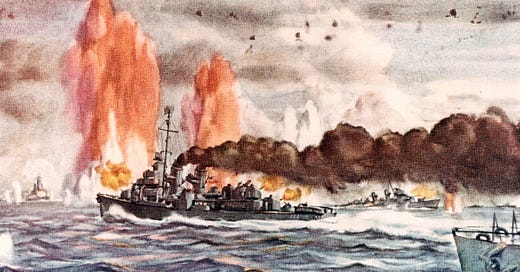





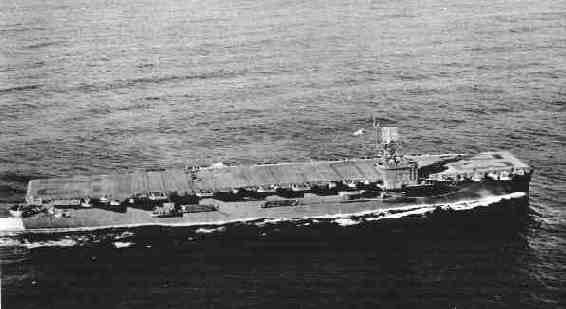


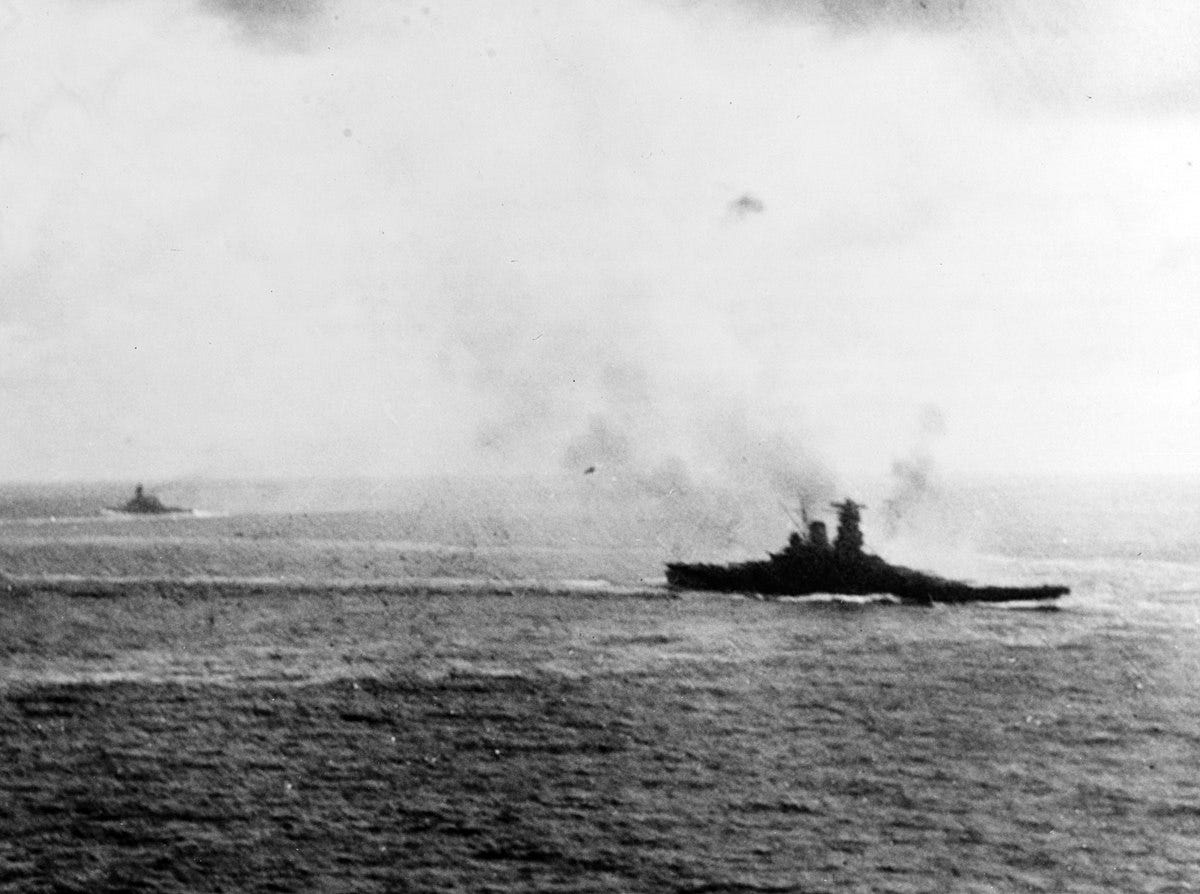



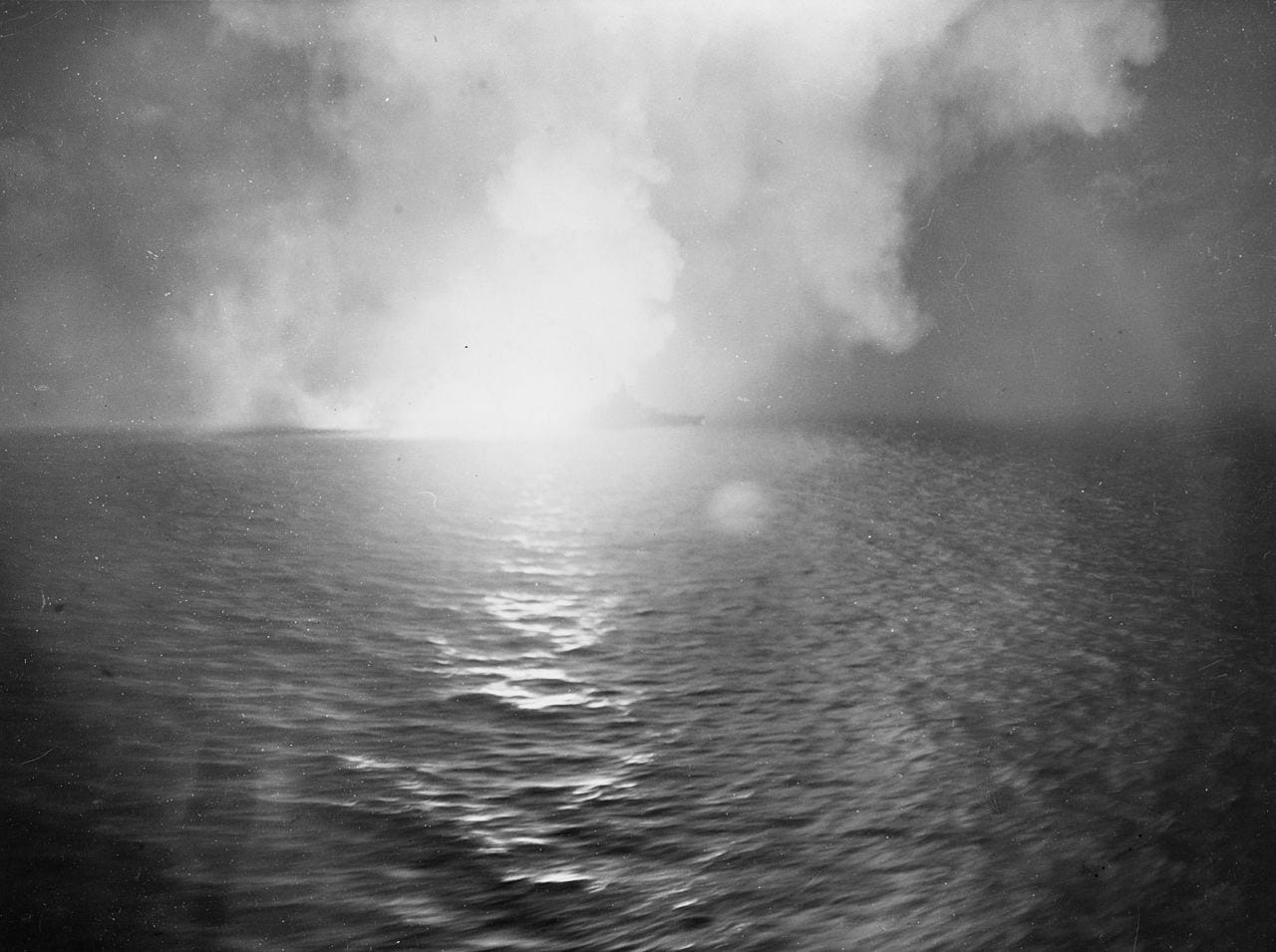


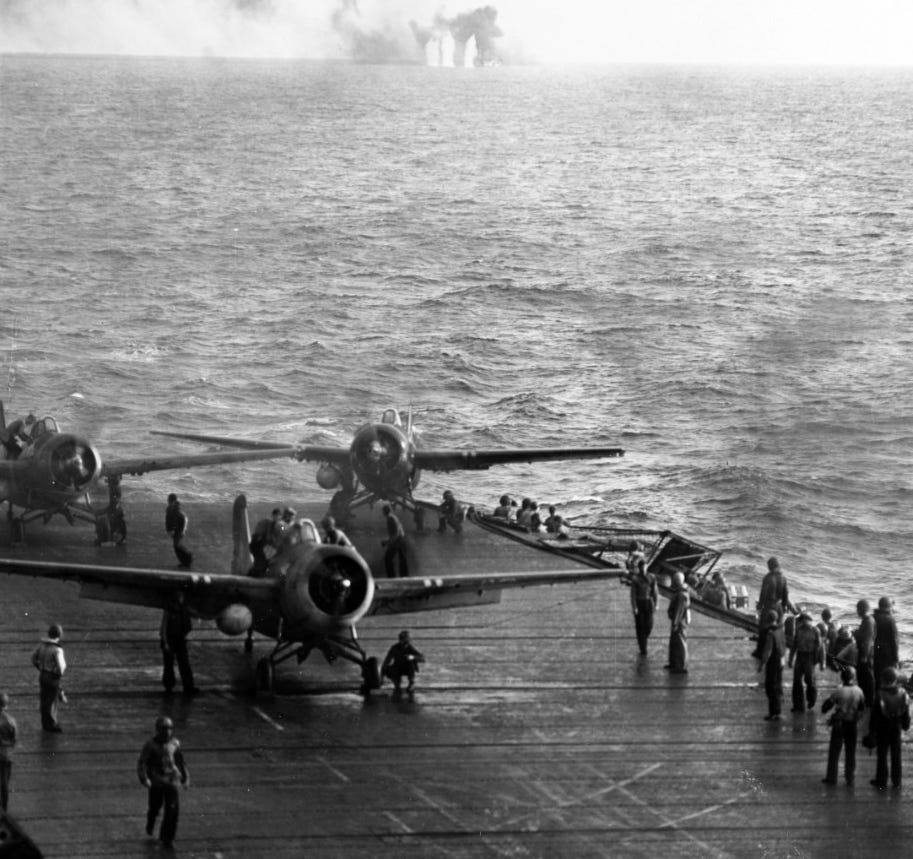
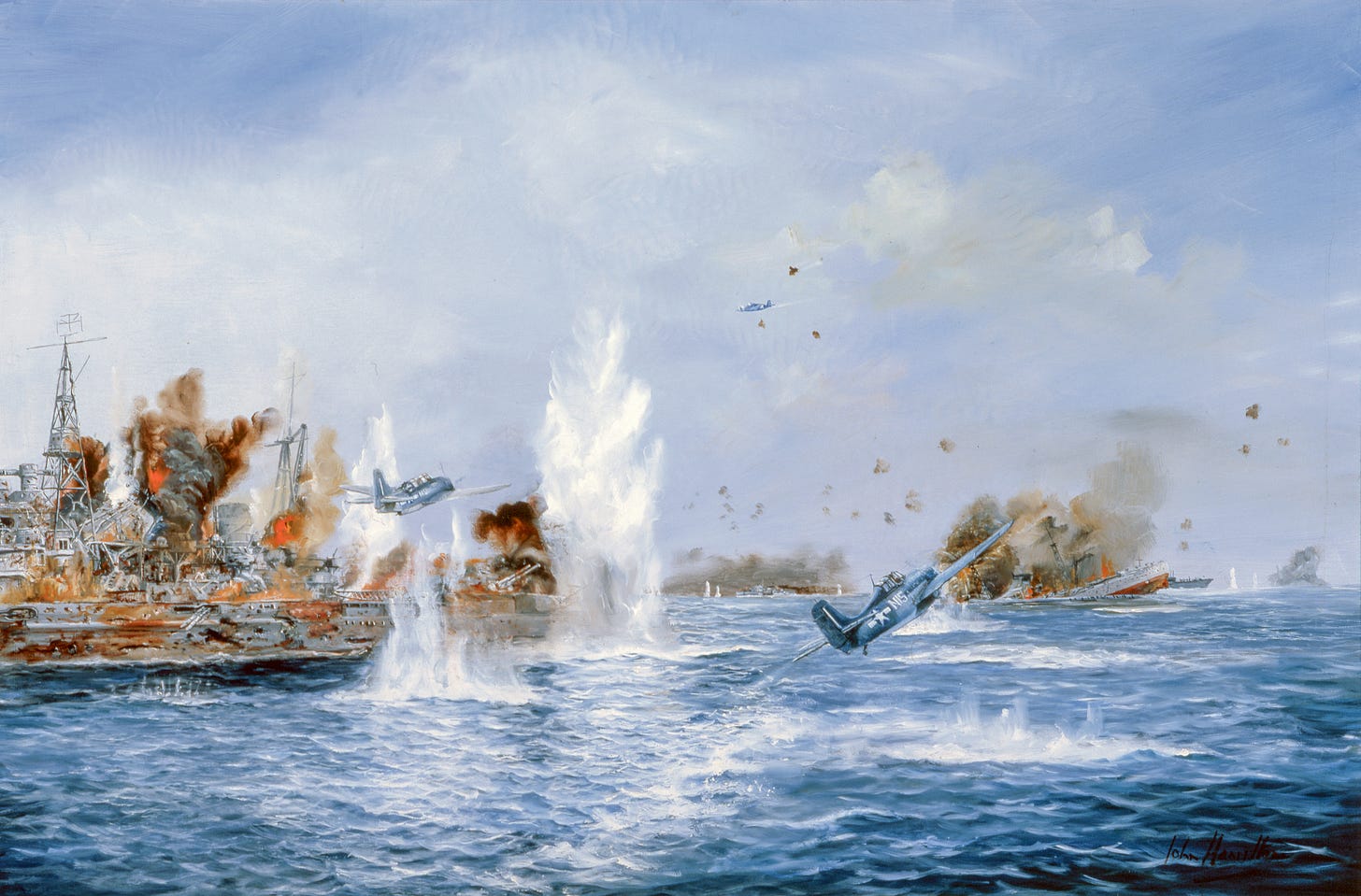




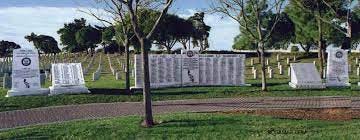


And on another part of the “field” David McCampbell and Roy Rushing off the Essex intercepted a gaggle of 40 Japanese planes. McCambell shot down nine, setting the American record for kills in a single sortie. Rushing got six.
True courage, dedication and sacrifice were shown by American sailors, soldiers, Marines and aircrews of my Dad’s generation. Excepting possibly of Korea the US has not fought a worthwhile war since WWII. Today’s military and support of our troops has died accordingly. Counting on a professional military with no conscripts leaves the rest of the country uncaring and National Leadership fighting for politics -